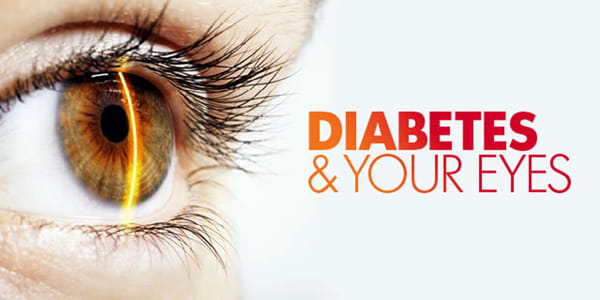The Diabetic Dilemma: How High Blood Sugar Takes a Toll on Eyes

Dr Asma Jabeen & Dr Nitin Kumar
In our overall health story, diabetes plays a significant role, affecting different parts of our well-being. One crucial area it influences is our eyes, where problems arise due to high blood sugar levels. Let’s take a closer look at how diabetes can impact our eyesight. As we explore this connection, it becomes evident that understanding and managing diabetes is not just a matter of maintaining overall health but is crucial for preserving the clarity and health of our vision.
Sugar’s Impact: Diabetes and Eye Health
Diabetes, a condition characterized by the body’s inability to regulate blood sugar effectively, can cast a shadow over Eye health. The eyes, being delicate organ, feel the impact of unregulated sugar levels throughout the body. To grasp how diabetes affects our eyes, let’s take a closer look at the challenges it brings. Taking care of our eyes means understanding this link and finding ways to keep the balance, like a sweet symphony for our vision. Regular check-ups and managing sugar levels play key roles in this eye health journey.
The Retinal Reflection: Diabetic Retinopathy (DR)
At the heart of the matter lies the retina, the light-sensitive layer at the back of the eye crucial for vision. Elevated blood sugar levels can wreak havoc on the delicate blood vessels nourishing the retina, leading to a condition known as diabetic retinopathy. In the early stages, DR often does not have noticeable symptoms, so the disease often goes undetected until it affects vision. Bleeding from damaged blood vessels in the retina can cause you to see “floaters,” or spots that appear across your field of vision. This silent yet potent consequence is a leading cause of blindness among adults.
Clouding Clarity: Cataracts and Diabetes
Diabetes can make the lens of the eye cloudy, like looking through foggy glasses. This can blur vision and make it difficult to see things clearly, especially at night or in bright light. Cataracts can gradually worsen over time, causing more trouble with seeing and carrying out daily tasks. Managing diabetes well and getting regular eye check-ups are important for catching cataracts early and keeping vision as clear as possible.
Silent Threat: Glaucoma and Diabetes
The optic nerve, responsible for sending signals from the eyes to the brain, is also affected by diabetes. Increased pressure can lead to glaucoma, a condition that can slowly take away peripheral vision. High blood sugar levels can trigger a cascade of changes in the eye, including the release of growth factors that stimulate the formation of new blood vessels. This process, known as neovascularization, can occur in the eye’s drainage angle, where fluid normally exits. The abnormal growth of these vessels can block fluid drainage, leading to increased pressure within the eye-a hallmark feature of glaucoma. Consequently, individuals with diabetes face an elevated risk of developing neovascular glaucoma, a subtype of glaucoma characterized by abnormal blood vessel formation in the iris. Understanding this link helps emphasize the need for regular eye check-ups for those with diabetes.
Diabetes and Dry eye challenges
Individuals with diabetes are also at an increased risk of developing dry eye. Dry eye occurs when there is insufficient lubrication on the surface of the eye, leading to discomfort, irritation, and potential damage to the cornea. Diabetes can contribute to dry eye syndrome by affecting the function of the tear glands, reducing tear production, and compromising the quality of tears.
What about styes?
Styes, characterized by tender red lumps on the outer edge of the eyelid, develop when a small oil gland close to the eyelashes becomes infected. They are more prevalent among individuals with diabetes.
Charting a Clearer Course: The Importance of Prevention and Care
While dealing with the impact of diabetes on eyesight may seem complicated, there’s hope. Managing blood sugar levels effectively, regular eye check-ups, and working closely with healthcare providers can make a significant difference. Early detection of eye issues related to diabetes allows for proactive steps to be taken, protecting eyesight and managing the challenges that come with diabetes. It can affect our eyesight, but with understanding and proactive care, we can navigate these challenges. By unraveling the complexities of how diabetes impacts our eyes, we empower ourselves to safeguard our vision, even when facing the difficulties that diabetes may bring.
A Path Forward: Empowering Your Vision Journey
As we navigate the intricate relationship between diabetes and eyesight, it’s crucial to recognize the power we have in shaping our vision journey. Education and awareness become our allies in this process. By adopting a healthy lifestyle that includes regular exercise, a balanced diet, and adherence to prescribed medications, individuals with diabetes can take significant strides in managing their overall health, consequently positively impacting their eyesight. Regular eye check-ups become not just a precautionary measure but an active engagement in the preservation of our visual well-being. In understanding the diabetic dilemma, we find the keys to unlocking a future where the gift of sight remains a cherished and protected aspect of our lives, even in the face of metabolic challenges.
(The authors are from the Department of Ophthalmology at AIIMS, Jammu).
